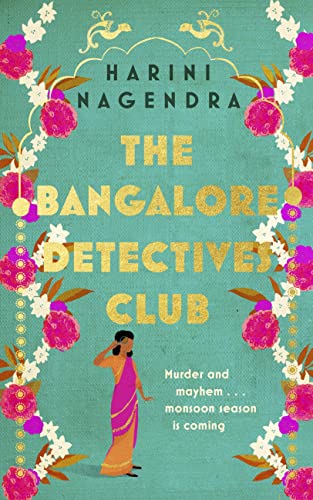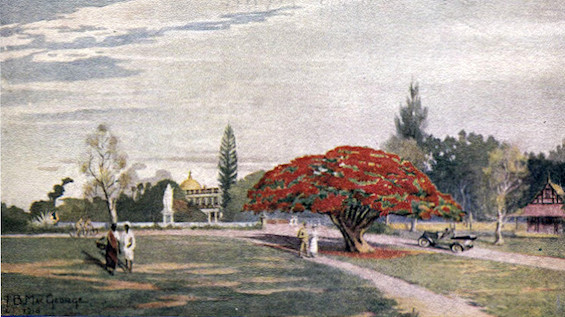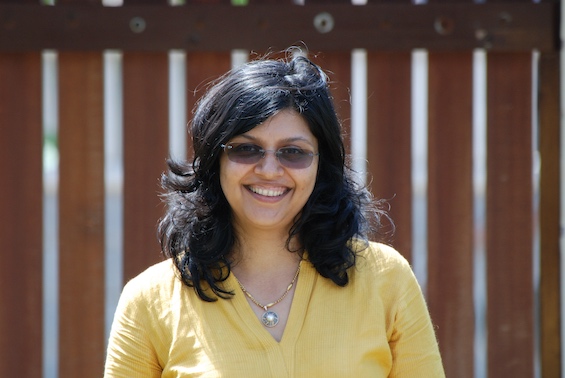
Estimated reading time: 5 minutes
Harini Nagendra’s debut in crime fiction, The Bangalore Detectives Club, opens in the South Indian city of Bangalore in 1921. It’s a gripping historical murder mystery but also well worth reading for its close observation of class and caste dynamics in India a century ago.
A doctor’s young wife becomes an amateur detective
Now nineteen, Kaveri Murthy has joined her husband for the first time at his home there. She had married Dr. Ramu Murthy unseen three years earlier but he insisted she complete her secondary studies before moving to the city. To her delight, and his, they are falling in love. And Ramu’s prestige as a surgeon, as well as his family’s wealth, have admitted her to the highest rungs of Bangalore society.
The only problem is, she can’t stand the limitations imposed on her as a wife and high-caste woman. Kaveri actually talks to the servants! And she is studying mathematics—in secret—in hopes of obtaining a university degree. Then, when the pair attend a formal dinner at an exclusive club, a mysterious man is murdered in the garden. And Kaveri’s curiosity leads her to depart even further from the role expected of her . . . by investigating the crime.
The Bangalore Detectives Club (Bangalore Detectives Club #1) by Harini Nagendra (2022) 304 pages ★★★★☆

Caste and class dynamics
Although still a teenager, Kaveri proves to be a shrewd investigator. But she is not alone in pursuing the mysterious case. Surprisingly, her husband, Ramu, supports her. He plays an essential role fronting for her in situations where no one would listen to a woman. And they are gratified to learn that the police detective assigned to the case welcomes both their efforts. The investigation becomes a joint effort of all three. And, make no mistake, no one of them could do the job alone. Because the case is fraught with family secrets, tense relationships between the English and the “natives,” and inter-class friction. The involvement of servants and other low-caste Indians offers Kaveri—and us—an opportunity to explore how class and caste intersect in the final decades of the British Raj.
A turning point in Indian history
The early 1920s were an inflection point in Indian history. More than a million soldiers returned from service for Britain in World War I, bringing heightened expectations of a better life. And the Indian National Congress stepped up its resistance to the British under the leadership of Mohandas Gandhi. It’s no coincidence, then, that two other prominent Indian authors have set their series of historical mysteries in that time. With The Widows of Malabar Hill, Sujata Massey launched a series of three novels to date featuring Perveen Mistry, the first woman lawyer in Bombay. And Abir Mukherjee’s series of five books to date about Calcutta-based detectives Sam Wyndham and Surendranath Banerjee debuted with A Rising Man.
About the historical research
In “1920s Bangalore, a city of diversities,” an article in Historia, The Magazine of the Historical Writers Association,” Nagendra writes about the difficulties she faced in researching the diverse voices in the city. “Writing about a colonial city with adequate depth and texture is not easy,” she writes, “because of the paucity of written records. The chronicles left behind for us to peruse document a singular, rather homogenous voice and perspective—that of a British (or British-educated Indian) bureaucrat or administrator, who is wealthy, privileged, and indubitably male.”
Yet The Bangalore Detectives Club focuses on the women of the city, and not just those of the upper class but many of the servants as well. Given the great difficulty she faced in tracking down written records about women and the poor a century ago, it’s clear Nagendra has done a stellar job of historical research.
About the author

Harini Nagendra leads the Center for Climate Change and Sustainability at Azim Premji University in Bangalore, India. Over the past 25 years, according to the university, Nagendra has been at the leading edge of research examining conservation in forests and cities of South Asia from the perspective of both landscape ecology and social justice. She has received numerous awards for her work and written several nonfiction books about ecology. The Bangalore Detectives Club is her first venture in mystery fiction.
For related reading
This is one of The best Indian detective novels. And this series is included in The best mystery series set in Asia.
I’ve reviewed the sequel to this novel at Murder Under a Red Moon (Murder in Bangalore brings corruption into the light). And check out two other excellent series-starters set in India during the same period:
- The Widows of Malabar Hill (Perveen Mistry #1) by Sujata Massey—The first woman lawyer in Bombay solves a baffling mystery
- A Rising Man (Wyndham and Banerjee #1) by Abir Mukherjee—A brilliant historical detective novel set in India following World War I
You might also enjoy my posts:
- Good books about India, past and present
- 10 top novels about private detectives
- 30 outstanding detective series from around the world
- Top 20 suspenseful detective novels
- Top 10 historical mysteries and thrillers
And you can always find my most popular reviews, and the most recent ones, on the Home Page.


























